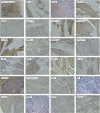Support vector machine-based nomogram predicts postoperative distant metastasis for patients with oesophageal squamous cell carcinoma
- PMID: 23942069
- PMCID: PMC3778272
- DOI: 10.1038/bjc.2013.379
Support vector machine-based nomogram predicts postoperative distant metastasis for patients with oesophageal squamous cell carcinoma
Abstract
Background: We aim to develop effective models for predicting postoperative distant metastasis for oesophageal squamous cell carcinoma (OSCC) for the purpose of guiding tailored therapy.
Methods: We used data from two centres to establish training (n=319) and validation (n=164) cohorts. All patients underwent curative surgical treatment. The clinicopathological features and 23 immunomarkers detected by immunohistochemistry were involved for variable selection. We constructed eight support vector machine (SVM)-based nomograms (SVM1-SVM4 and SVM1'-SVM4'). The nomogram constructed with the training cohort was tested further with the validation cohort.
Results: The outcome of the SVM1 model in predicting postoperative distant metastasis was as follows: sensitivity, 44.7%; specificity, 90.9%; positive predictive value, 81.0%; negative predictive value, 65.6%; and overall accuracy, 69.5%. The corresponding outcome of the SVM2 model was as follows: 44.7%, 92.1%, 82.9%, 65.9%, and 70.1%, respectively. The corresponding outcome of the SVM3 model was as follows: 55.3%, 93.2%, 87.5%, 70.7%, and 75.6%, respectively. The SVM4 model was the most effective nomogram in prediction, and the corresponding outcome was as follows: 56.6%, 97.7%, 95.6%, 72.3%, and 78.7%, respectively.Similar results were observed in SVM1', SVM2', SVM3', and SVM4', respectively.
Conclusion: The SVM-based models integrating clinicopathological features and molecular markers as variables are helpful in selecting the patients of OSCC with high risk of postoperative distant metastasis.
Figures


Similar articles
-
Cyclin D1 expression predicts postoperative distant metastasis and survival in resectable esophageal squamous cell carcinoma.Oncotarget. 2016 May 24;7(21):31088-96. doi: 10.18632/oncotarget.9078. Oncotarget. 2016. PMID: 27145270 Free PMC article.
-
Prognostic nomogram for previously untreated patients with esophageal squamous cell carcinoma after esophagectomy followed by adjuvant chemotherapy.Jpn J Clin Oncol. 2016 Apr;46(4):336-43. doi: 10.1093/jjco/hyv206. Epub 2016 Jan 26. Jpn J Clin Oncol. 2016. PMID: 26819278 Free PMC article.
-
Nomogram for prediction of lymph node metastasis in patients with superficial esophageal squamous cell carcinoma.J Gastroenterol Hepatol. 2020 Jun;35(6):1009-1015. doi: 10.1111/jgh.14915. Epub 2019 Dec 15. J Gastroenterol Hepatol. 2020. PMID: 31674067
-
Molecular prognostic prediction for locally advanced nasopharyngeal carcinoma by support vector machine integrated approach.PLoS One. 2012;7(3):e31989. doi: 10.1371/journal.pone.0031989. Epub 2012 Mar 9. PLoS One. 2012. PMID: 22427815 Free PMC article. Clinical Trial.
-
Development of a nomogram for the prediction of pathological complete response after neoadjuvant chemoradiotherapy in patients with esophageal squamous cell carcinoma.Dis Esophagus. 2017 Feb 1;30(2):1-8. doi: 10.1111/dote.12519. Dis Esophagus. 2017. PMID: 27868287
Cited by
-
Artificial intelligence-assisted esophageal cancer management: Now and future.World J Gastroenterol. 2020 Sep 21;26(35):5256-5271. doi: 10.3748/wjg.v26.i35.5256. World J Gastroenterol. 2020. PMID: 32994686 Free PMC article. Review.
-
Contourlet textual features: improving the diagnosis of solitary pulmonary nodules in two dimensional CT images.PLoS One. 2014 Sep 24;9(9):e108465. doi: 10.1371/journal.pone.0108465. eCollection 2014. PLoS One. 2014. PMID: 25250576 Free PMC article.
-
MIIP expression predicts outcomes of surgically resected esophageal squamous cell carcinomas.Tumour Biol. 2016 Aug;37(8):10141-8. doi: 10.1007/s13277-015-4633-2. Epub 2016 Jan 29. Tumour Biol. 2016. PMID: 26825982
-
Cyclin D1 expression predicts postoperative distant metastasis and survival in resectable esophageal squamous cell carcinoma.Oncotarget. 2016 May 24;7(21):31088-96. doi: 10.18632/oncotarget.9078. Oncotarget. 2016. PMID: 27145270 Free PMC article.
-
Magnetic resonance radiomics signatures for predicting poorly differentiated hepatocellular carcinoma: A SQUIRE-compliant study.Medicine (Baltimore). 2021 May 14;100(19):e25838. doi: 10.1097/MD.0000000000025838. Medicine (Baltimore). 2021. PMID: 34106622 Free PMC article.
References
-
- Chen HY, Yu SL, Chen CH, Chang GC, Chen CY, Yuan A, Cheng CL, Wang CH, Terng HJ, Kao SF, Chan WK, Li HN, Liu CC, Singh S, Chen WJ, Chen JJ, Yang PC. A five-gene signature and clinical outcome in non-small-cell lung cancer. N Engl J Med. 2007;356:11–20. - PubMed
-
- Gebski V, Burmeister B, Smithers BM, Foo K, Zalcberg J, Simes J, Australasian Gastro-Intestinal Trials Group Survival benefits from neoadjuvant chemoradiotherapy or chemotherapy in oesophageal carcinoma: a meta-analysis. Lancet Oncol. 2007;8:226–234. - PubMed
-
- Gerlinger M, Rowan AJ, Horswell S, Larkin J, Endesfelder D, Gronroos E, Martinez P, Matthews N, Stewart A, Tarpey P, Varela I, Phillimore B, Begum S, McDonald NQ, Butler A, Jones D, Raine K, Latimer C, Santos CR, Nohadani M, Eklund AC, Spencer-Dene B, Clark G, Pickering L, Stamp G, Gore M, Szallasi Z, Downward J, Futreal PA, Swanton C. Intratumor heterogeneity and branched evolution revealed by multiregion sequencing. N Engl J Med. 2012;366:883–892. - PMC - PubMed
-
- Guo Y, Chen Z, Zhang L, Zhou F, Shi S, Feng X, Li B, Meng X, Ma X, Luo M, Shao K, Li N, Qiu B, Mitchelson K, Cheng J, He J. Distinctive microRNA profiles relating to patient survival in esophageal squamous cell carcinoma. Cancer Res. 2008;68:26–33. - PubMed
Publication types
MeSH terms
Substances
LinkOut - more resources
Full Text Sources
Other Literature Sources
Medical

